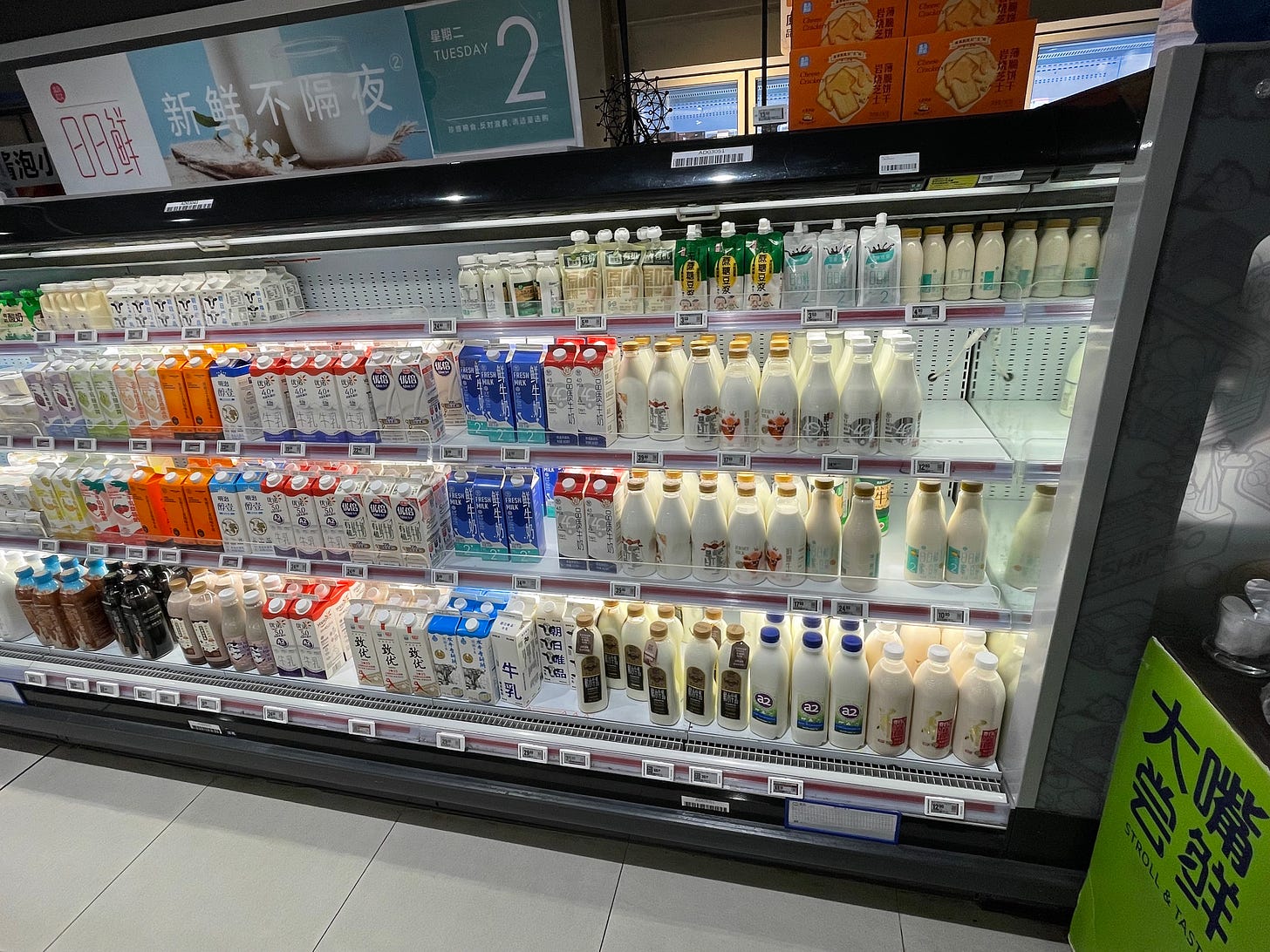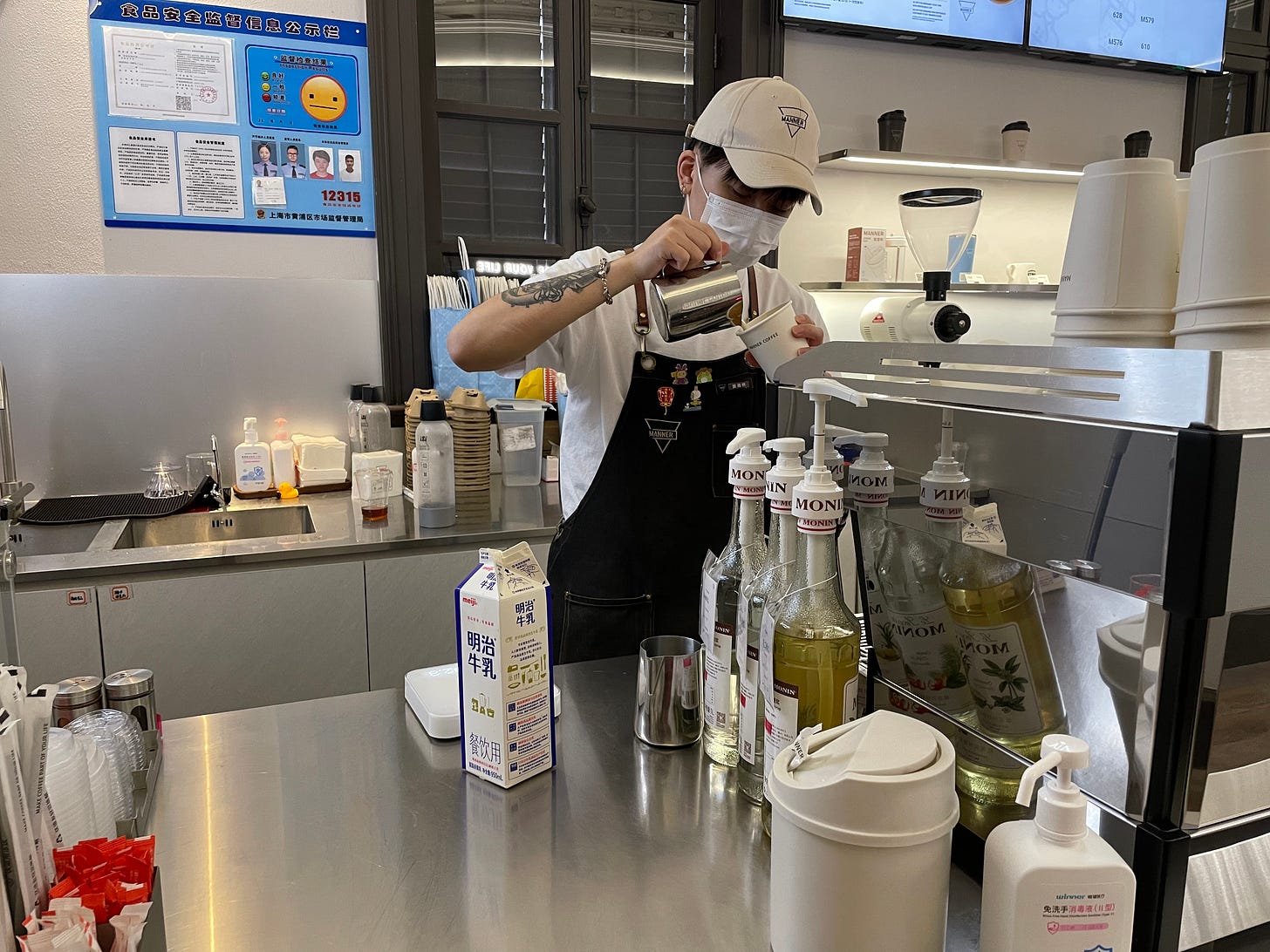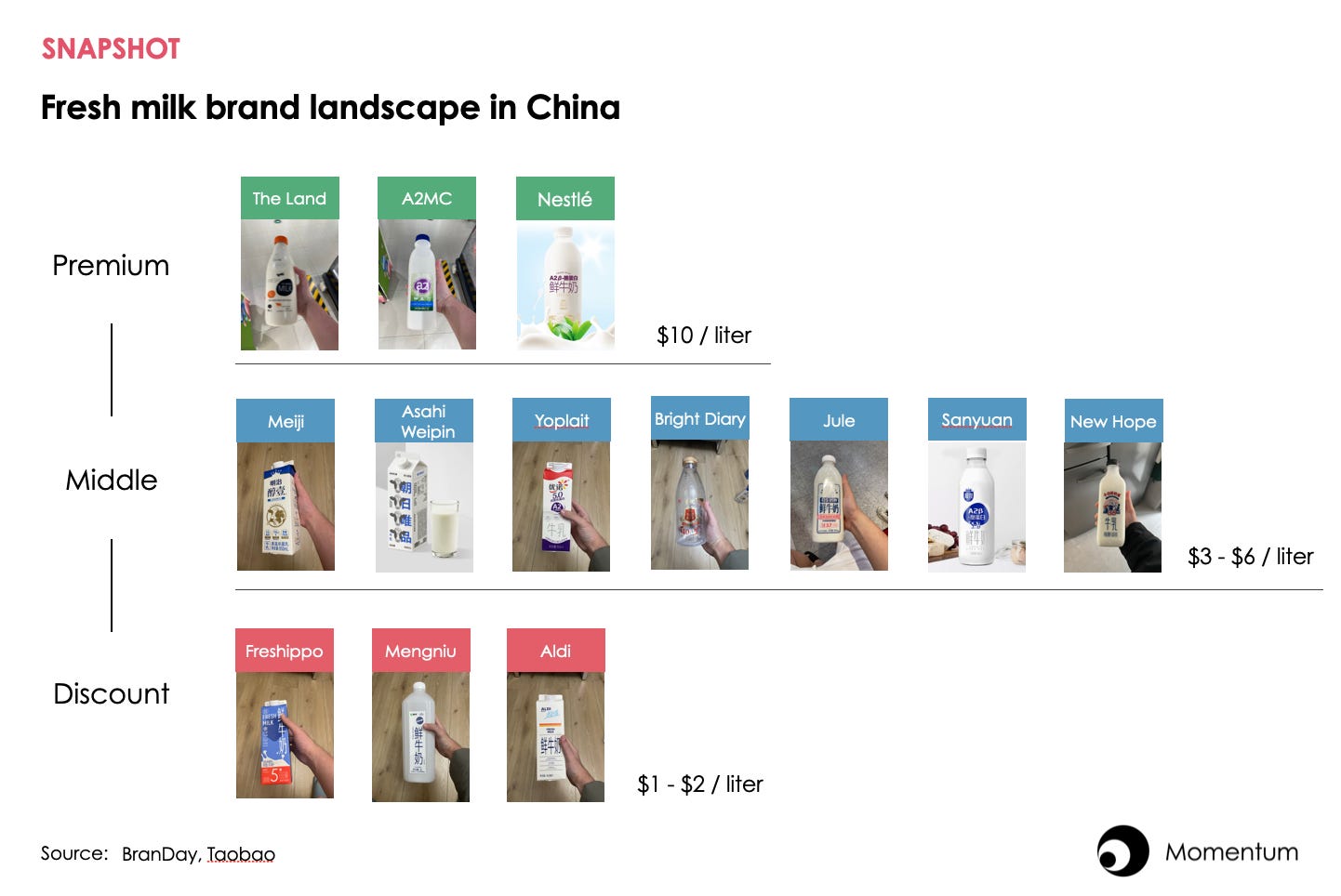Will top shelf milk be the next big thing in China, or the next flop?
As the fresh milk category explodes, a number of international and domestic players are emerging to fight over this once neglected area, but who will come out on top?
Article Highlights:
Amidst the aftermath of quality scandals, China's fresh milk market faces a critical crossroads, challenged by supply issues and an evolving industry reputation.
While a promising surge in consumer preference for fresh milk emerges, it's the booming coffee market that has amplified this shift, driving a market transformation.
But as sourcing challenges and competition from international brands loom large, can China's fresh milk truly redefine its position and capture a growing consumer base?
Plagued by the melamine milk scandal and supply issues, the popularity of fresh milk has been limited by local supply and industry reputation. It relies on imported shelf-stable fluid milk products to fill the demand gap, as fresh milk is hardly seen on the shelves.
Since 2008, the Chinese dairy market has mostly suffered due to a scandal involving food safety when it was discovered that producers were using melamine to mask protein content in baby formula. Soon after, it was found milk for all ages was tainted with the adulterant. As a result of illness and public outcry, the Chinese government prompted a rigorous investigation and regulation of the milk industry. This event substantially impacted the image of domestic milk and milk products for many years, allowing international players to dominate.
However, the winds are changing.
We are witnessing a significant increase in attention towards fresh milk in China now. There is a major shift happening in consumer preferences—from shelf-stable dairy beverages to a preference for fresh milk products, which have a better taste but usually have a shorter shelf life.
(“Fresh milk” in this context refers to varieties that require refrigeration for freshness, including pasteurized and ultra-pasteurized options.)
So, what's driving this change?
The answer is at least partially due to the booming coffee beverage market. Fresh milk consumption has been steadily rising since 2015, surpassing the growth rate of shelf-stable milk. This has coincided with the rapid growth of coffee consumption in China over the past eight years.
Milk plays a vital role in the coffee industry, as the most popular type of coffee in China, the Latte, typically contains over 80% milk per cup. To stay competitive, many brands have turned to higher-priced fresh milk to enhance their products.
For example, Manner Coffee, a Chinese coffee chain that has just opened its 1,000th store in Shanghai, pursues cost-effectiveness in coffee while persistently using good coffee beans and fresh milk to ensure coffee quality.
According to insiders, the quality of milk significantly impacts the taste of coffee. “Good milk can even rejuvenate an ordinary coffee bean,” an owner of a coffee shop explained to me. ”Although fresh milk costs a bit more, it shows characteristics of my coffee. If I don't provide good milk, my loyal customers will notice.”
David Chen, a coffee enthusiast who also works as a doctor, emphasized that high-quality fresh milk has the potential to create an addictive experience for consumers.
“After developing a passion for coffee, I realized that fresh milk has a unique aroma. It's a common phenomenon - once individuals experience the taste of something exceptional, they are unable to go back. That's why, when I intend to purchase milk today, whether it is for myself or my family, I rarely choose shelf-stable milk.”
Seemingly, the increased focus by coffee brands and the expansion of the specialty coffee culture has inadvertently raised consumer awareness about milk quality differences.
Furthermore, the impact of lactose intolerance on the younger generations in China, previously believed to deter milk consumption, may not be as severe as imagined. Healthcare professionals at immunization centers were educated to recommend parents to give their children milk, and in 2000, China initiated the "Student Milk Program" to encourage students to drink milk, helping many mild lactose intolerant individuals adapt to milk consumption.
As the Guardian noted:
Older generations of Chinese, who were not accustomed to dairy products, are often lactose intolerant. But if infants continue to consume milk, they may maintain some capacity to produce lactase, reducing the bloating often associated with milk.
Under the combined impact of coffee culture promotion and government education on milk consumption habits, there appears to be a significant opportunity for fresh milk products. This opportunity arises from two main factors: the increasing consumption of milk overall and the rising preference for fresh milk over shelf-stable alternatives.
So, how big will the fresh milk market get?
According to a report from Soochow Securities, China's fresh milk market reached around $6 billion in 2021. The annual growth rate for the next five years is estimated to be around 8%. Per capita fresh milk consumption is approximately 14 kg per year, which is one-third of the international average. This means there is a chance for the entire market to double or even more. However, in many undeveloped cities, it is not always possible to buy fresh milk anytime and anywhere.
An insider from Chongqing TianYou Diary (重庆天友乳业)told me, “Retailers in small cities may not have qualified refrigerators. Even if they do, they may not consistently maintain the required temperature due to concerns about electricity costs. This poses a significant challenge to our channel management.”
Therefore, subscribing to a daily delivery service to enjoy fresh milk is the mainstream in this type of market.
For instance, in a fifth-tier city like Pingxiang (萍乡), near Changsha, fresh milk can only be found in a few supermarkets. To enjoy fresh milk, Pingxiang residents typically order milk from brands that offer delivery services every morning, such as the local brand Sunshine (阳光) or the Shanghai brand Bright Diary (光明).

In a nutshell, the current growth potential of fresh milk is not limited to developed areas alone. The nationwide revolution of fresh milk replacing shelf-stable milk is underway.
To date, numerous brands have entered the fresh milk market including long-established brands, such as Mengniu (蒙牛), Bright Diary (光明), and Meiji, as well as some regionally focused brands like Chengdu's Jule (菊乐), Chongqing's TianYou ( 天友) and Beijing's Sanyuan (三元).
Of course, a few directly imported brands have also entered this segment. Australia-based A2 milk is the brand that has emerged on top in this niche market. Surprisingly, A2 fresh bottled milk is sold for $3 in Australia, but is priced at $10 after being directly imported to China. Despite the higher price , it maintains substantial sales volume and consistently ranks in the top ten in the fresh milk category during the recent Double 11 event.

Why is such pricey milk popular in China?
First, because the average price of the category is already high.
According to an industry insider, the main reason for this is that the production cost of milk in China is significantly high, with a cost of $0.768/kg for raw milk produced on farms. In contrast, in New Zealand, the cost is $0.272/kg. In other words, without considering other expenses, the price of raw materials in China is already more than double compared to developed dairy regions.This is not difficult to explain why the average price of the fresh milk market in China reaches $2, which is twice as high as in the United Kingdom and the United States.
Second, because A2MC's product quality is categorically superior.
According to Alvarez, good milk has to have a smooth, slightly sweet flavor that leaves a clean, pleasant aftertaste. I have been conducting my own personal experiment and have evaluated 10 different brands based on the standard from Alvarez, and here is what I have found.
The taste profile of milk from higher-priced brands is said to be better than that of lower-priced brands. For example, A2MC and another brand from New Zealand both have a unique sweetness and rich aftertaste. On the other hand, regular fresh milk priced between $2-$3 doesn't have a distinctive aroma and has a diluted taste, similar to plain water.
All in all, given the higher average price of the segment and the superior quality of imported milk, it is understandable that A2MC's price point may seem excessively high while continuing to sell well.
(Unfortunately, I haven't had the chance to taste the ten-dollar fresh milk from Nestle, which uses local Chinese milk sources, as it requires advance booking, which is a bit inconvenient. . If I have the opportunity in the future, I will add my thoughts on it.)
What can we expect in the future of the premium fresh milk category in China?
Now, the competition in China's premium fresh milk market is mainly between brands with external raw milk resources. Considering the current scarcity of imported brands in the market, it might appear like there is a supply shortage.
However, this sector will likely have increasingly strict import restrictions in the future as the Chinese government wants to protect domestic brands. So, for overseas companies looking to import, apart from ensuring the quality of milk, the most important focus should be to access regulatory approval.
Furthermore, no brand has ventured into the premium segment to produce flavored fresh milk. While chocolate, vanilla, orange, and strawberry flavors have already gained popularity in the shelf-stable and middle-priced fresh milk categories, Chinese consumers generally have a preference for sweet flavors. As a result, high-end fresh milk offerings with these popular flavors are likely to be well-received.

Interestingly, all the top fresh milk brands in China that I mentioned, except Nestlé, claim to be the Hermès of the milk industry. Honestly, it’s hard to say which brand will ultimately become the one and only Hermès in the eyes of consumers; maybe the true winner has yet to come out.
At the end of the day, this market should not be limited solely to the monotonous “Who is Hermès” battle. Wouldn't it be more captivating if LV, Chanel, and Gucci could also participate and thrive in this sector?
China's fresh milk market, with its intricate dance of supply challenges and evolving consumer preferences, is undeniably on the brink of change. The thriving coffee industry, coupled with an increasing awareness of quality and taste among consumers, is propelling fresh milk to the forefront of dairy consumption.
As an outside company looking into China, things might look extremely rosy and enticing – and maybe they are. However, as it has occurred in other other markets like Japan, there is always a risk of increasing regulation to protect domestic producers. The real blue ocean might be in domestic production, where one is safer from regulation, has simpler supply chains, and can build stronger relationships with local stakeholders.





It's a shame that China, a country with a long history of soy milk consumption, finds itself developing a new tradition linked with an industry criticized for its environmental impact, animal welfare practices, and contributions to climate change.